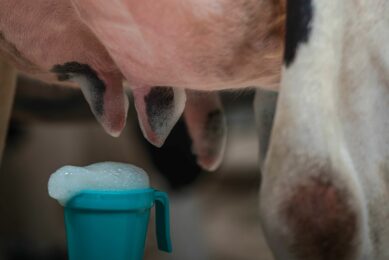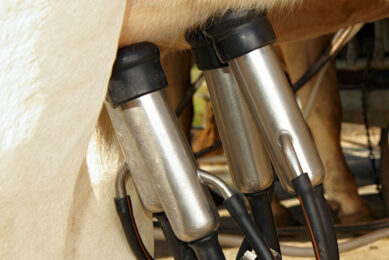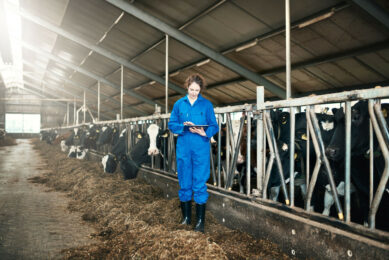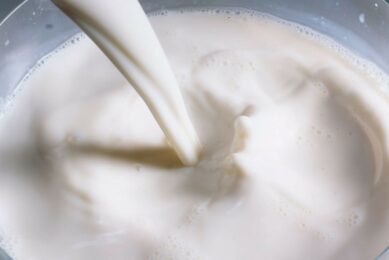Training heifers on a ‘phantom’ milking robot
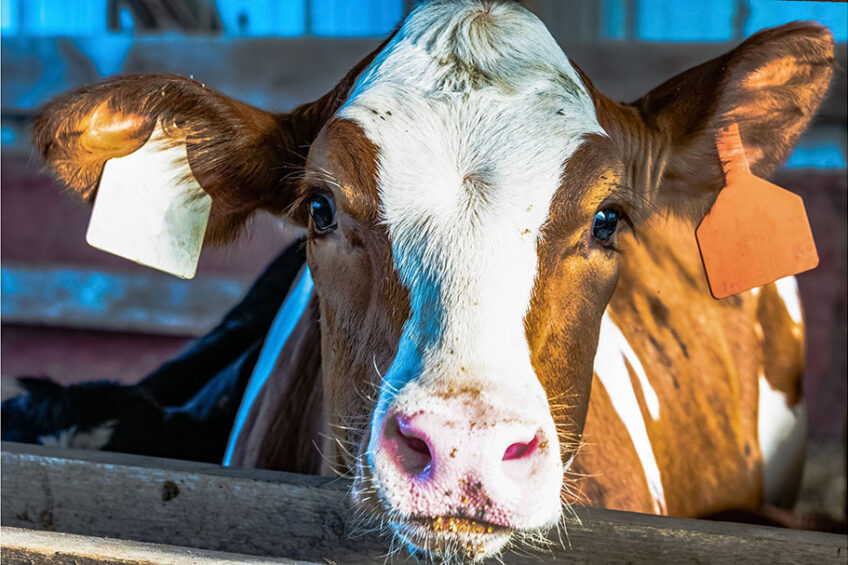
Training heifers on a phantom milking robot (automatic milking system), helps acclimatise them for the following lactation at the actual automatic milking system. This is the finding from research conducted on Holstein-Friesian heifers in Germany.
Introducing heifers into the automatic milking system (AMS) is associated with stress for both animals and farm employees, as completely inexperienced heifers initially do not independently enter the unknown milking robot. Researchers from Leipzig University and Martin Luther University in Germany found that training heifers on an AMS phantom is a good alternative to a training programme directly at the AMS. “This approach can be an important contribution to improving animal welfare in dairy farming,” they remarked.
Setting up the milking robot phantom
This study investigated whether training heifers on an AMS phantom provides the possibility of preparing heifers for the following lactation at the AMS. A total of 77 Holstein-Friesian heifers were randomly assigned to one of two experimental groups: control (CON) or phantom (PHAN).
At 4 weeks before calving, the PHAN group was given free access to the phantom, which was similar to the actual milking robot, so that they could explore it and be positively conditioned by feeding concentrate in the phantom. The heifers of the CON group had no contact with the phantom or the AMS before the first milking at the AMS.
In the ‘phantom’, the milking arm does not attach to the udder of the animals, but only visually corresponds to the milking arm of the AMS. In addition, the typical sound of the AMS is played through a speaker. Compared with previous studies of training at the actual AMS, this allowed the animals a comparatively long acclimatisation period. The benefits of the phantom were measured through milking visits, lactation performance and a reduction in stress.
Milking visits and animal behaviour
To evaluate how the animals accepted the AMS after calving, the researchers recorded the milking frequency per animal per day and the proportion of animals that had to be fetched for milking. The animals trained on the phantom showed higher milking frequency (2.70 visits/d) than the control animals (2.41 visits/d) between day 4 and day 10 of lactation. In addition, between day 1 and day 5, the proportion of animals that had to be fetched for milking was lower in the phantom (35.2%) group than in the control group (48%).
Because animals trained on the phantom showed a significantly higher number of milking visits between day 4 and day 10 of lactation, the researchers concluded that the trained animals were familiar with the AMS and therefore entered the milking robot more frequently. “The trained animals seemed to be able to transfer their acquired behaviour of regularly visiting the phantom to get their concentrate feed to the actual milking robot,” they said.
In addition to the number of milking visits per day, the fetching data also indicates that animals trained on the phantom accepted the AMS better than the control animals. In line with this observation, several workers were needed to drive the animals of the control group into the AMS compared to this being almost not required in the phantom group. “This can lead to an important relief for both animals and farm employees, and could be labour cost-effective,” they said.
Figure – Proportion of animals that had to be fetched for milking during early lactation
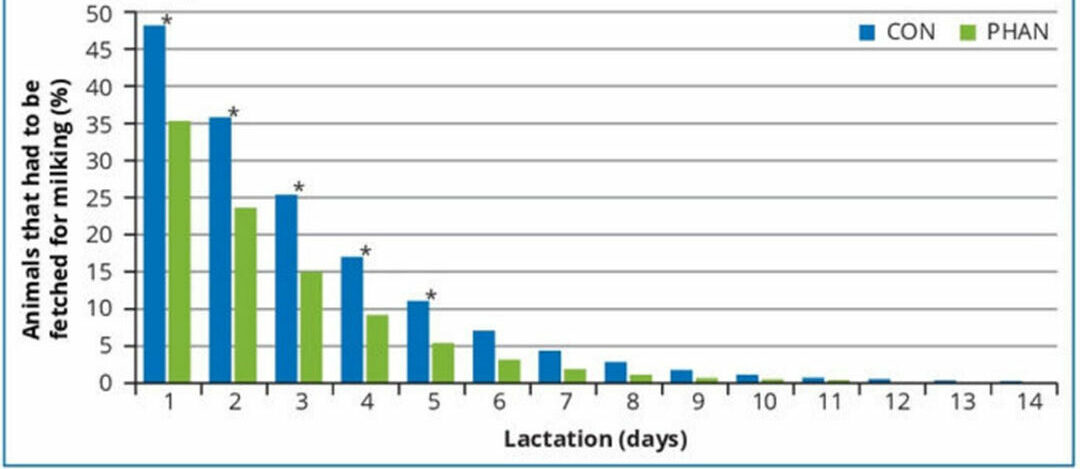
Lactation and calving performance
Besides affecting animal welfare, the stress experienced during or before milking can adversely affect lactation performance of heifers. Stress caused by milking in unfamiliar surroundings is of particular importance, as it can lead to a central inhibition of the oxytocin release thereby disturbing milk ejection. This can have a negative effect on milk flow rate and milk yield. However, in this study, researchers did not measure milk flow rate. The daily milk yield did not differ between trained and untrained animals.
“We suspect that the increase in milking frequency of PHAN did not differ sufficiently from that of CON, or that the period of higher milking frequency was not long enough to lead to a significantly higher daily milk yield,” they concluded. There were also no differences between either protein or fat content of the milk.
To assess the effects of phantom training on udder health, the researchers considered electrical conductivity during the experimental period and mastitis prevalence in first lactation cows in the 2-year period before installation of the phantom and the subsequent 2 years. As is already known, in mammary infections the permeability between milk and blood is altered, leading to higher ion concentration in the milk, which results in increased electrical conductivity. In their study, in all 4 quarters, milk conductivity of PHAN cows tended to be lower than that of CON, indicating a positive effect of the phantom on udder health. The researchers, however, advised using more health parameters instead of using only this measure as a sole parameter of udder health.
The calving process was normal for 67.6% of CON and 79.1% of PHAN heifers. Heifers of CON had a higher percentage of impaired calving performance (32.4%) than did heifers of PHAN (20.9%). At 14.3%, the stillbirth rate of CON was markedly higher than that of PHAN (4.7%).
Reduced stress
Because a new environment such as the AMS can act as a severe stressor, cortisol levels were determined to assess the stress of the animals in the experiment. The researchers expected that animals that had previously been trained on the phantom would suffer less stress on the actual milking robot during the acclimatisation period and that this would be reflected in lower faecal cortisol concentrations compared with untrained animals. But no difference was observed.
“It could be that the introduction into the AMS is only a minor stressor for the animals, which is not reflected in faecal cortisol concentrations. On the other hand, the determination of faecal glucocorticoid metabolites does not seem to be the appropriate method to assess possible stress situations during introduction into the AMS, as, for example, it is not possible to differentiate between birth-related and stress-related cortisol secretion,” they said. Rumination time was also not different between the 2 groups. A general conclusion was made that the effects of calving and then regrouping might have reduced the effects of the phantom on rumination time.
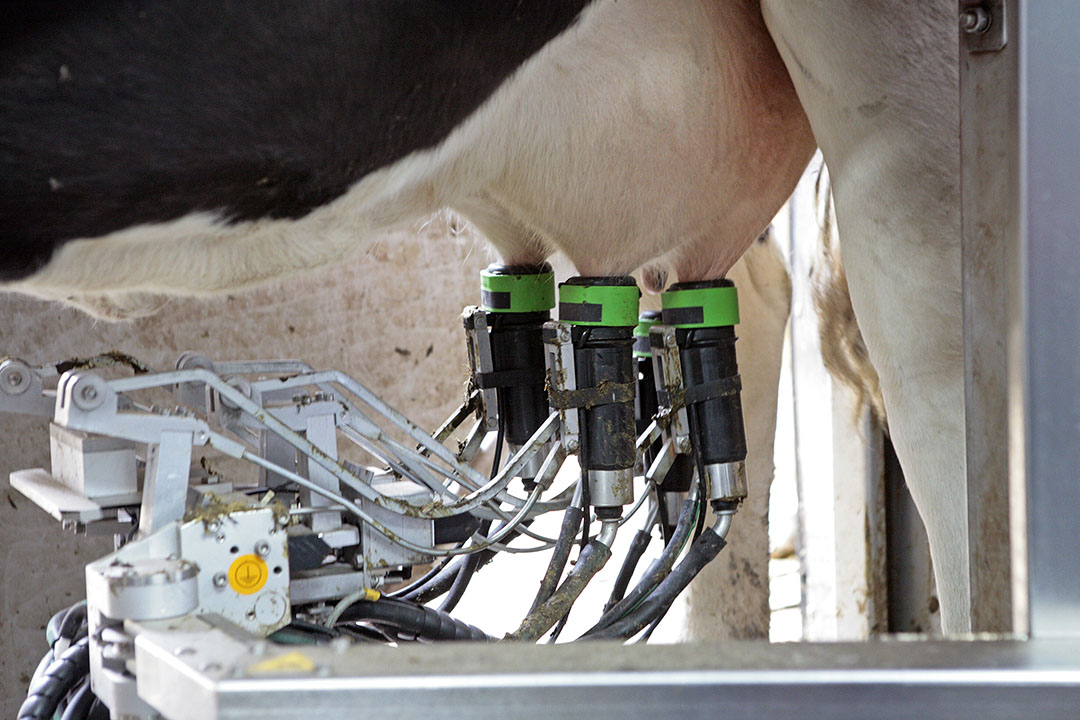
Overall, the increased number of milking visits and the reduced proportion of animals that had to be fetched into the AMS for milking indicate that training on the phantom prepares heifers well for being milked in the AMS. Therefore, training heifers on the phantom offers the possibility to facilitate the start into early lactation for the animals, providing a valuable contribution to improvement of animal welfare and reduced stress to the trainers.
This article is based on the original article by Von Kuhlberg M.K., Wensch-Dorendorf M., Gottschalk J., Wagner T., Herrmann N., Einspanier A., et al. 2021. The effects of a training programme using a phantom to accustom heifers to the automatic milking system. J. Dairy Sci. 104:928–936.
Join 13,000+ subscribers
Subscribe to our newsletter to stay updated about all the need-to-know content in the dairy sector, two times a week.



